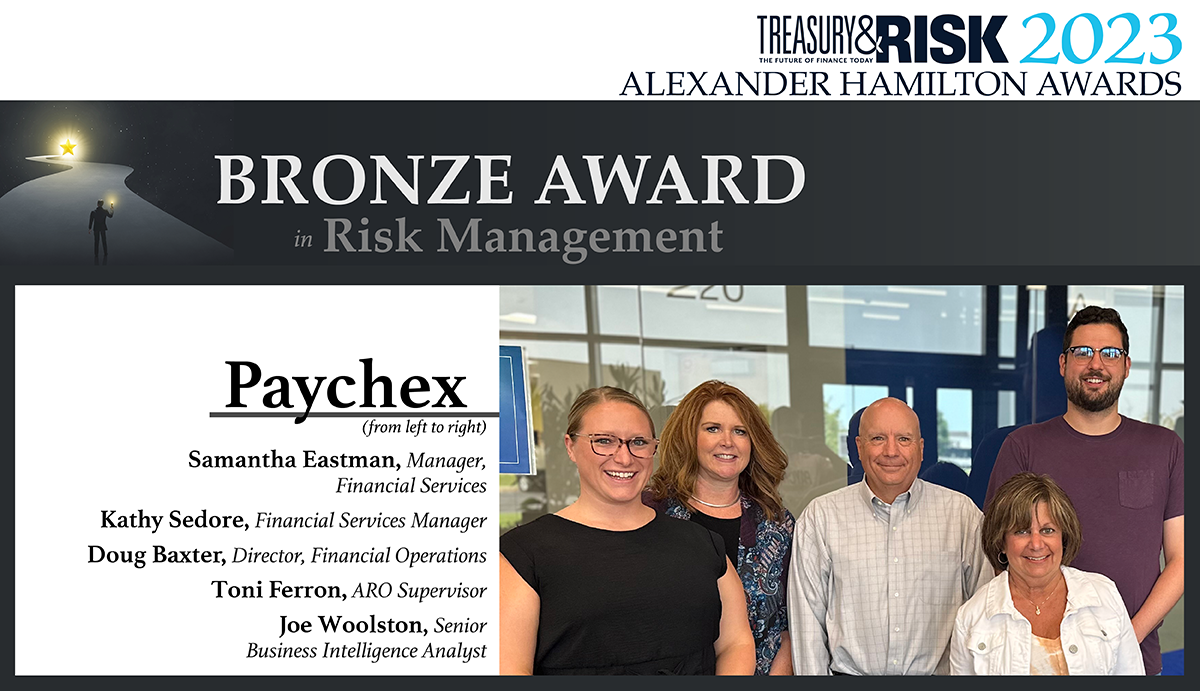
Many clients that subscribe to Paychex 401(k) services receive discounts early in the contract. Over time, the company recaptures this revenue by reducing the discounts year by year until eventually eliminating them. This gradual phaseout means discount decisions can get complex fast.
"In the interest of customer retention, we typically avoid removing the discounts all at once, which would result in a sizable price increase for the client," explains Doug Baxter, director of financial operations for Paychex. However, the company's billing software was not designed to accommodate this approach. "The system perpetuates the same discount for a particular client until an employee goes in and changes it. So, in the past, we had a manual process for figuring out how to adjust discounts."
Recommended For You
This process was cumbersome for everyone involved. Managers in the 401(k) business unit would set a high-level rolldown percentage. The service reporting team would use Microsoft Access to combine dozens of datasets and generate an initial list of discounts for specific clients, a process that involved more than 100 Access queries. Accounts receivable (A/R) specialists would then analyze each client relationship within multiple Excel spreadsheets to develop a discount for the client for the coming year, and would work with the customer service department to anticipate and mitigate potential issues related to the price change.
"When reps would use the Excel spreadsheets to figure each client's discount, it wasn't very clear what the end result would be from a revenue standpoint," says Joe Woolston, senior business intelligence analyst. "They would look at how long the client had been on the service, what discount they were receiving, how long the discount had been in effect, what 401(k) plan they were on, etc. Management decisions were based partly on financial forecasts and partly on feedback from internal service providers to determine the impact on specific clients when they were put into the system. Once an individual client's annual discount was finalized, a separate group—the risk management team—would enter the amount into Paychex's billing system."
Once a month, the accounts receivable operations (ARO) team ran a quality audit to verify that the correct discount for each client had been entered into the financial system. And the ARO business analysts would run VLOOKUPs in Excel after the fact to calculate revenue the company had missed out on because of the discounts. The work was manual and required a great deal of staff time across multiple departments. It also created opportunities for human error.
"The original process was arduous to work through," Baxter says. "The risk management team began looking at opportunities to improve the process, and we quickly discovered that Paychex wasn't even capturing all the discounts in our analysis. We saw this as an opportunity to simultaneously improve the process and positively impact the bottom line."
Another factor driving the need for improvement was the expectation that the business would be expanding in the near future. "Recently, a lot of states have passed legislation requiring 401(k) plans, which obviously drives more plans for Paychex," Baxter points out. "We needed to make the discounting process scalable and easier to manage as our business grows."
Baxter formed a project team that included Woolston as well as Samantha Eastman, manager of financial services for Paychex. Their goals were threefold: First, to simplify the discount selection process by defining an easily understood selection logic that would justify why a specific discount was or was not included in the dataset being analyzed. Second, to automate calculations and assignments of discounts. And third, to improve audit tasks.
"The project team met with our business partners to discuss the requirements," Eastman says. "We went through the original process and talked about our goals of making A/R teams self-sufficient and shortening the discounting process through automation. We explained that rather than being handed a spreadsheet to wade through, we wanted them to receive all the information they needed so that they wouldn't have to spend time figuring out the details. We also wanted to create a workflow to streamline and standardize their workloads."

To reach this desired future state, the project team focused on developing a solution that would help management of the 401(k) group more easily select a business-wide rolldown percentage each year, while also providing end users with the appropriate information. Cleaning up the discount dataset was a key component of this work.
"The old process was using an unnecessarily large dataset, bringing in a bunch of data points that weren't relevant to the discount process," Woolston says. "When we stepped back and thought about what our end goal was, we determined that a lot of the data points being pulled in weren't relevant and were adding layers of complexity to our process."
The team replaced the 100-plus Access queries with a single SQL procedure that retrieves all discounts from the company's proprietary customer management system and inserts them into a SQL Server projection table. "From there, the system runs a series of UPDATE statements on them," Baxter says. "We built in logic so that SQL can make all the necessary calculations regardless of whether the discount is a dollar amount or a percentage in the proprietary system."
They built SQL queries that automate the assignment of an end date for discounts and that flag clients eligible for the discount rolldown. The system also confirms that the service to which the discount is applied is still being billed to the client—in other words, that the customer is still using it. Then, they automated the division of labor.
"SQL divides up the discount workload over the course of the year so that the A/R specialists don't have 17,000 accounts to work in one month," Baxter says. "SQL processes do a dynamic assignment, so newer reps might get 10 or 20 accounts while senior reps get more like 100. We plug all that into an Access form, hit a button, and it assigns the accounts to individual users." Within their unique queue, A/R specialists can see all the information about each client's discount situation before making a final decision on the discount and entering it into Paychex's financial systems.
Next, the team created an Access form and a SQL process that enables the leadership team in the 401(k) department to run revenue forecast scenarios. They can adjust variables, and Access will generate a new table that reflects monthly and annual projections of the 401(k) division's client count, recaptured revenue, and other metrics. "They might look at 'If we roll down each discount by 50 percent, we'll save X amount of revenue, whereas if we roll down by 35 percent, we will get a different figure,'" Woolston explains.
Because this process completes in mere seconds, management can run scenarios on demand to determine any prospective change's impact on cash flows and, ultimately, to identify the optimal level of discounting. "They make that determination based on a balance of recapturing as much revenue as possible, while keeping the client experience in mind," Woolston adds. "They know their clients and understand the industry, so they can make a decision of how to price and how aggressive to be on the discounts."
The 2024 Alexander Hamilton Awards program is open for submissions through September 1, 2023. Learn more here, and enter today!
See also:
- Gold Award—Microsoft: "Leveraging the Blockchain to Improve the Supply Chain"
- Silver Award—Morgan Stanley: "Tapping a Wealth of Data to Improve Portfolio Risk Management"
This scenario-planning functionality was made possible by sophisticated logic that the team developed through extensive use case discussions with the business units. "That process spanned a couple of months, but we wanted to make sure that with all the different scenarios and combinations of data points, we were considering all the information we needed around discounts," Woolston says. "We wanted the system to show us not just the amount and length of the discount, but also the reason behind the discount—Is it for client retention? Does it come from the zone manager? Previously, getting all the answers took weeks, so we only did this once a year. Now we're evaluating discounts on a monthly basis to make sure our revenue goals are still on track."
"One of the most important changes we made is giving management a forecasting tool so that they can understand what type of revenue we're going to generate with a specific change in the discount," Baxter says. "That way, as they look at how prospective discounts are going to affect the client base, they can also see the effect on their ability to reach their financial goals."
The project team built audit functionality into the Access database, as well. They coded a SQL function that compares each client's expected discount, as generated within Access, against the actual discount entered into the billing system. Whenever a discrepancy arises, the system notifies the appropriate A/R specialists within the discount workflow so that they can identify and track corrections.
The new system and processes have reduced staff time spent calculating discounts by more than 100 hours annually, while eliminating the risk that someone might accidentally delete key information from one of the Excel spreadsheets. The improved data management has caught more than 5,000 discounts that had not been phased out under the legacy process.
"Simplifying the process has meant that we are able to capture discounts that previously we missed," Baxter says. "While our policy is that discounts should be reduced every year, we found some that had been on the books for four or five years and had not been rolled down or end-dated." The amount of revenue recaptured each year has been significant for Paychex.
In addition, Baxter adds, "we have dramatically reduced risk in the discounting process. A lot of that is because the system now gives the end users a predetermined amount of what the new dollar amount should be. Not only that, but our audits are run on a monthly basis, and the system will tell them if an error was made so that they can go back in immediately and figure it out. The whole process is much more seamless, controlled, and dynamic now.
"We're a finance and risk organization, but we work within an agile technology company," Baxter concludes. "Our senior management team encourages employees to find better ways to do things. With this project, we have demonstrated that creating value for the company doesn't require a significant spend or significant IT resources."

© Touchpoint Markets, All Rights Reserved. Request academic re-use from www.copyright.com. All other uses, submit a request to [email protected]. For more inforrmation visit Asset & Logo Licensing.



